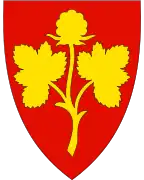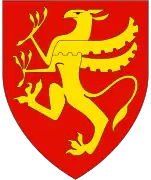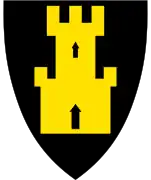Nesseby
Unjárga (Northern Sami) or Nesseby (Norwegian)[3] (also unofficially Uuniemi in Kven and Finnish) is a municipality in Troms og Finnmark county, Norway. The administrative centre of the municipality is the village of Varangerbotn. Other villages in Nesseby include Gandvik, Karlebotn, Nesseby, and Nyelv. The European route E06 and European route E75 highways intersect at Varangerbotn in Nesseby.
Nesseby kommune
Unjárgga gielda | |
|---|---|
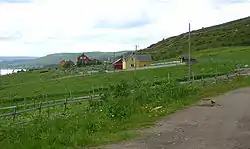 Abelsborg in Nesseby municipality | |
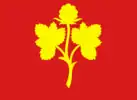 Flag 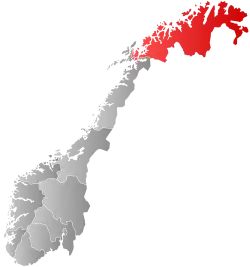 Troms og Finnmark within Norway | |
 Nesseby within Troms og Finnmark | |
| Coordinates: 70°10′24″N 28°33′13″E | |
| Country | Norway |
| County | Troms og Finnmark |
| District | Øst-Finnmark |
| Established | 1839 |
| • Preceded by | Vadsø landdistrikt |
| Administrative centre | Varangerbotn |
| Government | |
| • Mayor (2011) | Knut Inge Store (Ap) |
| Area | |
| • Total | 1,436.95 km2 (554.81 sq mi) |
| • Land | 1,365.93 km2 (527.39 sq mi) |
| • Water | 71.02 km2 (27.42 sq mi) 4.9% |
| • Rank | #62 in Norway |
| Population (2022) | |
| • Total | 854 |
| • Rank | #343 in Norway |
| • Density | 0.6/km2 (2/sq mi) |
| • Change (10 years) | |
| Demonym | Nessebyværing[1] |
| Official languages | |
| • Norwegian form | Bokmål |
| • Sámi form | Northern Sami |
| Time zone | UTC+01:00 (CET) |
| • Summer (DST) | UTC+02:00 (CEST) |
| ISO 3166 code | NO-5442 |
| Website | Official website |
The 1,437-square-kilometre (555 sq mi) municipality is the 62nd largest by area out of the 356 municipalities in Norway. Nesseby is the 343rd most populous municipality in Norway with a population of 854. The municipality's population density is 0.6 inhabitants per square kilometre (1.6/sq mi) and its population has decreased by 5.2% over the previous 10-year period.[4][5]
On 1 January 2020, the municipality became part of the newly formed Troms og Finnmark county. Previously, it had been part of the old Finnmark county.[6]
Name
The official name of the municipality was Nesseby before 1989 when it was changed to Unjárga-Nesseby.[7] It was the second municipality in Norway to get a Sami name. In 2005, the name was again changed, such that either Unjárga or Nesseby can be used.[8]
The municipality (originally the parish) is named after the old Nesseby farm, since Nesseby Church was built there (in 1858). The first element is nes which means "headland" and the last element is by which means "town".[9]
The meaning of the first element (u-) in the Sami name is unknown and the last element is njárga which means "headland".[9]
Coat of arms
The coat of arms was granted on 27 June 1986. The official blazon is "Gules, a cloudberry plant Or couped at base" (Norwegian: I rødt en opprett gul molteplante). This means the arms have a red field (background) and the charge is a cloudberry plant (Rubus chamaemorus). The cloudberry plant has a tincture of Or which means it is commonly colored yellow, but if it is made out of metal, then gold is used. Cloudberry plants are commonly found in the municipality and the Finnmark region, growing in marshes and wet fields. The berries are collected and eaten locally as well as commercially exported to other parts of Norway. The berries are at first red, but when ripe they get a golden or orange colour, so the colour combination of yellow and red was used on the arms to represent this. The arms were designed by Arvid Sveen.[10][11][12]
History


Wild reindeer used to cross the isthmus in prehistoric times until the year 1900, causing extensive human activity throughout the millennia. Therefore, the area is full of archeological finds from different periods.
The municipality of Nesseby was originally established in 1839 when the western part of the Vadsø landdistrikt was separated to form Nesseby. Initially, there were 598 residents. This was short-lived, however, since the two were merged back together in 1858. On 1 January 1864, the municipality of Nesseby was again created from the western district of Vadsø landdistrikt. The initial population (this time) was 886. The western part of Nesseby (population: 450) was separated on 1 January 1903 to form the new municipality of Polmak.[13]
Economy
In 2013, 26% of jobs of were within the health sector and social sector; 8% were within education; there were 373 jobs in the municipality.[14] The hydroelectric power station, Gandvik kraftverk produces [around] 20.1 gigawatt-hours (72 TJ) (as of 2021).[15]
Commercial fish processing has been going on at Kløvnes since 2017.[16]
The innermost marina in the Varanger Fjord (Kløvnes havn near Nesseby Church) is operating at full capacity - 32 vessels; many of those are fishing vessels.[16]
Geography
The municipality is situated on the isthmus between the Varangerfjord and the Tana River at the entrance to the Varanger Peninsula. All the people live in small settlements along the fjord. Varangerhalvøya National Park is partially located in the park. The river Jakobselva partially forms the municipal border between Nesseby and Vadsø to the northeast.
Birdlife
The municipality of Unjárga-Nesseby is known for its interesting birding localities and is mentioned in several birding guide books. Other than the Varangerford, the main habitat is tundra with areas of bog and marsh. One species that can usually be seen on small ponds during the summer months is the red-necked phalarope.
Climate
| Climate data for Varangerbotn | |||||||||||||
|---|---|---|---|---|---|---|---|---|---|---|---|---|---|
| Month | Jan | Feb | Mar | Apr | May | Jun | Jul | Aug | Sep | Oct | Nov | Dec | Year |
| Daily mean °C (°F) | −11.9 (10.6) |
−11.0 (12.2) |
−7.4 (18.7) |
−2.3 (27.9) |
3.1 (37.6) |
8.6 (47.5) |
12.2 (54.0) |
10.5 (50.9) |
6.1 (43.0) |
0.3 (32.5) |
−5.7 (21.7) |
−9.9 (14.2) |
−0.6 (30.9) |
| Average precipitation mm (inches) | 27 (1.1) |
22 (0.9) |
21 (0.8) |
21 (0.8) |
24 (0.9) |
37 (1.5) |
55 (2.2) |
53 (2.1) |
44 (1.7) |
41 (1.6) |
34 (1.3) |
31 (1.2) |
410 (16.1) |
| Source: Norwegian Meteorological Institute[17] | |||||||||||||
Government
All municipalities in Norway, including Nesseby, are responsible for primary education (through 10th grade), outpatient health services, senior citizen services, unemployment and other social services, zoning, economic development, and municipal roads. The municipality is governed by a municipal council of elected representatives, which in turn elect a mayor.[18] The municipality falls under the Indre Finnmark District Court and the Hålogaland Court of Appeal.
Municipal council
The municipal council (Kommunestyre) of Nesseby is made up of 15 representatives that are elected to four year terms. The party breakdown of the council is as follows:
| Party Name (in Norwegian) | Number of representatives | |
|---|---|---|
| Labour Party (Arbeiderpartiet) | 7 | |
| Conservative Party (Høyre) | 1 | |
| Sámi People's Party (Samefolkets Parti) | 2 | |
| Centre Party (Senterpartiet) | 3 | |
| Socialist Left Party (Sosialistisk Venstreparti) | 1 | |
| Cross-Party List (Tverrpolitisk liste) | 1 | |
| Total number of members: | 15 | |
| Party Name (in Norwegian) | Number of representatives | |
|---|---|---|
| Labour Party (Arbeiderpartiet) | 7 | |
| Sámi People's Party (Samefolkets Parti) | 3 | |
| Socialist Left Party (Sosialistisk Venstreparti) | 2 | |
| Cross-Party List (Tverrpolitisk liste) | 3 | |
| Total number of members: | 15 | |
| Party Name (in Norwegian) | Number of representatives | |
|---|---|---|
| Labour Party (Arbeiderpartiet) | 6 | |
| Progress Party (Fremskrittspartiet) | 2 | |
| Conservative Party (Høyre) | 2 | |
| Sámi People's Party (Samefolkets Parti) | 2 | |
| Socialist Left Party (Sosialistisk Venstreparti) | 2 | |
| Cross-Party List (Tverrpolitisk liste) | 1 | |
| Total number of members: | 15 | |
| Party Name (in Norwegian) | Number of representatives | |
|---|---|---|
| Labour Party (Arbeiderpartiet) | 6 | |
| Progress Party (Fremskrittspartiet) | 3 | |
| Conservative Party (Høyre) | 1 | |
| Sámi People's Party (Samefolkets Parti) | 2 | |
| Cross-Party List (Tverrpolitisk liste) | 3 | |
| Total number of members: | 15 | |
| Party Name (in Norwegian) | Number of representatives | |
|---|---|---|
| Labour Party (Arbeiderpartiet) | 6 | |
| Progress Party (Fremskrittspartiet) | 3 | |
| Conservative Party (Høyre) | 2 | |
| Sámi People's Party (Samefolkets Parti) | 3 | |
| Cross-Party List (Tverrpolitisk liste) | 3 | |
| Total number of members: | 17 | |
| Party Name (in Norwegian) | Number of representatives | |
|---|---|---|
| Labour Party (Arbeiderpartiet) | 6 | |
| Conservative Party (Høyre) | 2 | |
| Sámi People's Party (Samefolkets Parti) | 2 | |
| Cross-Party List (Tverrpolitisk liste) | 5 | |
| Free voters (Frie velgere) | 2 | |
| Total number of members: | 17 | |
| Party Name (in Norwegian) | Number of representatives | |
|---|---|---|
| Labour Party (Arbeiderpartiet) | 7 | |
| Conservative Party (Høyre) | 2 | |
| Sámi List (Samefolkets liste) | 3 | |
| Cross-Party List (Tverrpolitisk liste) | 5 | |
| Total number of members: | 17 | |
| Party Name (in Norwegian) | Number of representatives | |
|---|---|---|
| Labour Party (Arbeiderpartiet) | 6 | |
| Conservative Party (Høyre) | 3 | |
| Sámi List (Samefolkets liste) | 2 | |
| Cross-Party List (Tverrpolitisk liste) | 6 | |
| Total number of members: | 17 | |
| Party Name (in Norwegian) | Number of representatives | |
|---|---|---|
| Labour Party (Arbeiderpartiet) | 8 | |
| Conservative Party (Høyre) | 1 | |
| Common List for Cross-Party Group and Centre Party (Fellesliste for tverrpolitiskgruppe og Senterpartiet) |
5 | |
| Sámi List (Samefolkets liste) | 3 | |
| Total number of members: | 17 | |
| Party Name (in Norwegian) | Number of representatives | |
|---|---|---|
| Labour Party (Arbeiderpartiet) | 9 | |
| Conservative Party (Høyre) | 1 | |
| Centre Party (Senterpartiet) | 2 | |
| Sámi List (Samefolkets liste) | 3 | |
| Cross-Party list for fishermen, farmers, and others (Tverrpolitisk liste for fiskere, småbrukere og andre yrkesgruppe) | 2 | |
| Total number of members: | 17 | |
| Party Name (in Norwegian) | Number of representatives | |
|---|---|---|
| Labour Party (Arbeiderpartiet) | 7 | |
| Conservative Party (Høyre) | 4 | |
| Centre Party (Senterpartiet) | 3 | |
| Sámi List (Samefolkets liste) | 3 | |
| Total number of members: | 17 | |
| Party Name (in Norwegian) | Number of representatives | |
|---|---|---|
| Labour Party (Arbeiderpartiet) | 7 | |
| Conservative Party (Høyre) | 2 | |
| Centre Party (Senterpartiet) | 2 | |
| Local List(s) (Lokale lister) | 2 | |
| Total number of members: | 13 | |
| Party Name (in Norwegian) | Number of representatives | |
|---|---|---|
| Labour Party (Arbeiderpartiet) | 7 | |
| Conservative Party (Høyre) | 3 | |
| Centre Party (Senterpartiet) | 2 | |
| Local List(s) (Lokale lister) | 1 | |
| Total number of members: | 13 | |
| Party Name (in Norwegian) | Number of representatives | |
|---|---|---|
| Labour Party (Arbeiderpartiet) | 7 | |
| Conservative Party (Høyre) | 4 | |
| List of workers, fishermen, and small farmholders (Arbeidere, fiskere, småbrukere liste) | 2 | |
| Total number of members: | 13 | |
| Party Name (in Norwegian) | Number of representatives | |
|---|---|---|
| Labour Party (Arbeiderpartiet) | 8 | |
| Conservative Party (Høyre) | 2 | |
| Christian Democratic Party (Kristelig Folkeparti) | 1 | |
| List of workers, fishermen, and small farmholders (Arbeidere, fiskere, småbrukere liste) | 2 | |
| Total number of members: | 13 | |
| Party Name (in Norwegian) | Number of representatives | |
|---|---|---|
| Labour Party (Arbeiderpartiet) | 4 | |
| Conservative Party (Høyre) | 3 | |
| Communist Party (Kommunistiske Parti) | 1 | |
| List of workers, fishermen, and small farmholders (Arbeidere, fiskere, småbrukere liste) | 4 | |
| Local List(s) (Lokale lister) | 1 | |
| Total number of members: | 13 | |
| Party Name (in Norwegian) | Number of representatives | |
|---|---|---|
| Labour Party (Arbeiderpartiet) | 7 | |
| Conservative Party (Høyre) | 2 | |
| Communist Party (Kommunistiske Parti) | 1 | |
| List of workers, fishermen, and small farmholders (Arbeidere, fiskere, småbrukere liste) | 3 | |
| Total number of members: | 13 | |
| Party Name (in Norwegian) | Number of representatives | |
|---|---|---|
| Labour Party (Arbeiderpartiet) | 6 | |
| Conservative Party (Høyre) | 2 | |
| Communist Party (Kommunistiske Parti) | 1 | |
| List of workers, fishermen, and small farmholders (Arbeidere, fiskere, småbrukere liste) | 3 | |
| Total number of members: | 12 | |
| Party Name (in Norwegian) | Number of representatives | |
|---|---|---|
| Labour Party (Arbeiderpartiet) | 4 | |
| Communist Party (Kommunistiske Parti) | 2 | |
| List of workers, fishermen, and small farmholders (Arbeidere, fiskere, småbrukere liste) | 6 | |
| Total number of members: | 12 | |
| Party Name (in Norwegian) | Number of representatives | |
|---|---|---|
| Labour Party (Arbeiderpartiet) | 5 | |
| List of workers, fishermen, and small farmholders (Arbeidere, fiskere, småbrukere liste) | 7 | |
| Total number of members: | 12 | |
| Party Name (in Norwegian) | Number of representatives | |
|---|---|---|
| Labour Party (Arbeiderpartiet) | 6 | |
| List of workers, fishermen, and small farmholders (Arbeidere, fiskere, småbrukere liste) | 2 | |
| Joint List(s) of Non-Socialist Parties (Borgerlige Felleslister) | 2 | |
| Local List(s) (Lokale lister) | 2 | |
| Total number of members: | 12 | |
| Note: Due to the German occupation of Norway during World War II, no elections were held for new municipal councils until after the war ended in 1945. | ||
Mayors
The mayors of Nesseby:[37]
- 1846–1847: Jørris Schelderup Hansen
- 1848–1849: Johan Christian Astrup
- 1849–1850: Jørris Schelderup Hansen
- 1850–1853: Christian Sommerfelt
- 1854-1854: Carl Johan Scanche
- 1855-1855: Christian Andreassen
- 1855–1856: Christian Sommerfelt
- 1856–1857: Christian Andreassen
- 1857–1859: Carl Johan Scanche
- 1859–1860: Andreas Nordvi
- 1863-1863: Hieronymus Heyerdahl
- 1865–1876: Otto Andreas Pleym, Sr.
- 1877–1879: Olaf Olafsen Lassen
- 1880-1880: Otto Andreas Pleym, Sr.
- 1881–1898: Johan Bjørvik Jacobsen
- 1899–1904: Otto Andreas Pleym, Jr.
- 1905–1913: Anton Olsen Hoem
- 1914–1915: Isak Saba (Ap)
- 1916–1925: Kristian Martin Andersen
- 1926–1931: Erling Hoem
- 1932–1934: Bernhard Haldorsen Skauge
- 1935–1937: Herman Anton Losvik
- 1938–1940: Julius Herman Endresen
- 1944–1945: Sverre Oskar Raddum
- 1945-1945: Julius Herman Endresen
- 1946–1950: Andreas Gustav Adolf Berg
- 1951–1954: Mathis Johan Saba
- 1954-1954: Julius Leonhard Johansen
- 1955-1955: Per Nilsen Balk
- 1956–1959: Truls Holm
- 1959-1959: Johan Petter Store
- 1960–1961: Einar Leonhard Samuelsen
- 1962–1967: Per Nilsen Balk
- 1968–1971: Otto Bjørvik Pleym (H)
- 1972–1975: Johan Per Erik Store (Ap)
- 1976–1979: Einar Rudolf Johansen (Ap)
- 1980–1983: Øystein Nilsen (Sp)
- 1984–1987: Einar Rudolf Johansen (Ap)
- 1988–1989: Thore Andreas Sundfær (Ap)
- 1990–1991: Mari-Ann Nilssen (H)
- 1991–1999: Jarle-Wilfred Andreassen (Ap)
- 1999–2003: Thore Andreas Sundfær (Ap)
- 2003–2007: Ann-Jorid Henriksen (Ap)
- 2007–2011: Inger Katrine Juuso (Ap)
- 2011–present: Knut Inge Store (Ap)
Culture
The building that is likely the oldest, is at [Nesseby graveyard] Nesseby kirkegård; it is [a small hut made of timber] tømmerstue, and it is probably from when the first chapel was built (year 1718) at Angsnes - further inside the fjord, according to media.[38]
Sami culture
Most inhabitants are of Sami origin, and today Sami is being taught as the first language in schools. The municipality has its own Sami costume.
A survey conducted on behalf of the Sami Language Council in the year 2000 showed that 75 percent of the population are Sami speakers.[39]
The Norwegian Sami Parliament's department of culture and environment is located in Unjárga-Nesseby. The Várjjat Sámi Museum is located in the municipality. The museum is about the sea-sami culture. Unjárga-Nesseby is also the birthplace of Isak Saba the first Sami to be elected into the Norwegian Parliament.
The popular teen-age pop-band The Blacksheeps come from Nesseby.
Churches
The Church of Norway has one parish (sokn) within the municipality of Nesseby. It is part of the Indre Finnmark prosti (deanery) in the Diocese of Nord-Hålogaland.
| Parish (sokn) | Church name | Location of the church | Year built |
|---|---|---|---|
| Nesseby | Nesseby Church | Nesseby | 1858 |
Notable people

- Søren Kristian Sommerfelt (1851–1934), Lutheran priest
- Anathon Aall (1867–1943), academic, philosopher and psychologist
- Isak Saba (1874–1921), the first Sami to be elected to the Stortinget
- Finn Lützow-Holm (1890–1950), military officer, aviation pioneer and polar explorer
- Anton Johnson Brandt (1893–1951), veterinarian and academic
- Signe Iversen (born 1956), Sami-language consultant and author of children's literature
- Raimo Valle (born 1965), civil servant and politician for the Labour Party
- Silje Karine Muotka (born 1975), member of the Sami Parliament of Norway
- Kirsti Bergstø (born 1981), politician for the Socialist Left Party
- Agnete Johnsen (born 1994), musician and lead singer of The BlackSheeps
References
- "Navn på steder og personer: Innbyggjarnamn" (in Norwegian). Språkrådet.
- "Forskrift om målvedtak i kommunar og fylkeskommunar" (in Norwegian). Lovdata.no.
- "Stadnamn og rettskriving" (in Norwegian). Kartverket. Retrieved 13 July 2018.
- Statistisk sentralbyrå. "Table: 06913: Population 1 January and population changes during the calendar year (M)" (in Norwegian).
- Statistisk sentralbyrå. "09280: Area of land and fresh water (km²) (M)" (in Norwegian).
- Mæhlum, Lars, ed. (24 December 2019). "Troms og Finnmark". Store norske leksikon (in Norwegian). Kunnskapsforlaget. Retrieved 26 December 2019.
- "Ot.prp. nr. 111 (2001-2002)" (in Norwegian). Regjeringen.no. 5 July 2002.
- "Endring av skrivemåten for tospråklige kommuner. Endring av skrivemåten for tospråklige kommunenavn, Unjárga-Nesseby" (in Norwegian).
- Rygh, Oluf (1924). Norske gaardnavne: Finmarkens amt (in Norwegian) (18 ed.). Kristiania, Norge: W. C. Fabritius & sønners bogtrikkeri. p. 246.
- "Civic heraldry of Norway - Norske Kommunevåpen". Heraldry of the World. Retrieved 22 January 2023.
- "Nesseby, Finnmark". Flags of the World. Retrieved 22 January 2023.
- "Godkjenning av våpen og flagg". Lovdata.no (in Norwegian). Norges kommunal- og arbeidsdepartementet. 11 July 1986. Retrieved 22 January 2023.
- Jukvam, Dag (1999). "Historisk oversikt over endringer i kommune- og fylkesinndelingen" (PDF) (in Norwegian). Statistisk sentralbyrå.
- https://www.statsforvalteren.no/siteassets/utgatt/fm-finnmark/dokument-fmfi/kommunal-styring/kommunereformen/nesseby.pdf. page 10. "Undervisning [...] 33 [8.8] [...] Helse og sosial [...] 100 [26.8] [...] 373"
- "Nesseby". 28 June 2021.
- Erik Brenli. "Planlegger for 15 nye liggeplasser". 2023-06-22. Finnmarken. P. 12
- "eKlima Web Portal". Norwegian Meteorological Institute. Archived from the original on 14 June 2004.
- Hansen, Tore, ed. (12 May 2016). "kommunestyre". Store norske leksikon (in Norwegian). Kunnskapsforlaget. Retrieved 30 May 2018.
- "Tall for Norge: Kommunestyrevalg 2019 - Troms og Finnmark". Valg Direktoratet. Retrieved 23 October 2019.
- "Table: 04813: Members of the local councils, by party/electoral list at the Municipal Council election (M)" (in Norwegian). Statistics Norway.
- "Tall for Norge: Kommunestyrevalg 2011 - Finnmark". Valg Direktoratet. Retrieved 23 October 2019.
- "Kommunestyrevalget 1995" (PDF) (in Norwegian). Oslo-Kongsvinger: Statistisk sentralbyrå. 1996. Retrieved 20 February 2020.
- "Kommunestyrevalget 1991" (PDF) (in Norwegian). Oslo-Kongsvinger: Statistisk sentralbyrå. 1993. Retrieved 20 February 2020.
- "Kommunestyrevalget 1987" (PDF) (in Norwegian). Oslo-Kongsvinger: Statistisk sentralbyrå. 1988. Retrieved 20 February 2020.
- "Kommunestyrevalget 1983" (PDF) (in Norwegian). Oslo-Kongsvinger: Statistisk sentralbyrå. 1984. Retrieved 20 February 2020.
- "Kommunestyrevalget 1979" (PDF) (in Norwegian). Oslo: Statistisk sentralbyrå. 1979. Retrieved 20 February 2020.
- "Kommunevalgene 1975" (PDF) (in Norwegian). Oslo: Statistisk sentralbyrå. 1977. Retrieved 16 March 2020.
- "Kommunevalgene 1972" (PDF) (in Norwegian). Oslo: Statistisk sentralbyrå. 1973. Retrieved 16 March 2020.
- "Kommunevalgene 1967" (PDF) (in Norwegian). Oslo: Statistisk sentralbyrå. 1967. Retrieved 16 March 2020.
- "Kommunevalgene 1963" (PDF) (in Norwegian). Oslo: Statistisk sentralbyrå. 1964. Retrieved 16 March 2020.
- "Kommunevalgene og Ordførervalgene 1959" (PDF) (in Norwegian). Oslo: Statistisk sentralbyrå. 1960. Retrieved 16 March 2020.
- "Kommunevalgene og Ordførervalgene 1955" (PDF) (in Norwegian). Oslo: Statistisk sentralbyrå. 1957. Retrieved 16 March 2020.
- "Kommunevalgene og Ordførervalgene 1951" (PDF) (in Norwegian). Oslo: Statistisk sentralbyrå. 1952. Retrieved 16 March 2020.
- "Kommunevalgene og Ordførervalgene 1947" (PDF) (in Norwegian). Oslo: Statistisk sentralbyrå. 1948. Retrieved 16 March 2020.
- "Kommunevalgene og Ordførervalgene 1945" (PDF) (in Norwegian). Oslo: Statistisk sentralbyrå. 1947. Retrieved 16 March 2020.
- "Kommunevalgene og Ordførervalgene 1937" (PDF) (in Norwegian). Oslo: Statistisk sentralbyrå. 1938. Retrieved 16 March 2020.
- Blix, Erik Schytte (1921). Ordførere i Nesseby kommune: 1846-1966 (in Norwegian). Varangerbotn: Nesseby kommune. ISBN 8277460058.
- Frans-Arne Stylegar. "Elsk og kirkedører". 2023-06-19. Klassekampen. P 13
- Sámi Ealáhus- ja Guorahallanguovddáš (2000). Undersøkelse av bruken av samisk språk. Page 15. Retrieved on March 9, 2023, from https://sametinget.no/_f/p1/i10537133-cd33-43ad-b3f1-ead094c523a4/underskelse-av-bruken-av-samisk-sprak-2000.pdf
External links
- http://www.nesseby.kommune.no/ Official homepage (in Norwegian)
- Municipal fact sheet from Statistics Norway (in Norwegian)
- http://www.varjjat.org/ Várjjat Sámi Museum (in Northern Sami)
- http://www.isaksaba.no/ Isak Saba center (in Northern Sami)
